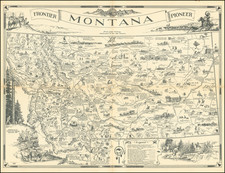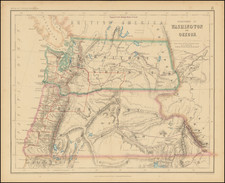One of the great maps in the record of Western Cartography
Nice example of the 1899 reprinting of W.W. De Lacy's 1865 map of Montana, referred to by Carl Wheat as "one of the great maps in the record of Western Cartography."
De Lacy, a civil engineer, and West Point graduate, had been commissioned by the Montana Territorial Legislature to produce a map of the Territory at its first meeting in the summer of 1864, following the formation of the Territory on May 16, 1864. De Lacy first issued this monumental map of Montana Territory and parts of Wyoming in 1865. The first edition of the map is known in 3 states, as noted by Saunders ( Imago Mundi, Vol 54, pp 129-134).
As noted by Saunders, two copies of De Lacey's original manuscript map were created by De Lacy, one of which "shipped east for printing." Within the first year after its creation, printed editions of the map were published by Julius Hutawa in St. Louis and by Rae Smith of New York. The Smith edition includes an inset "Map showing the Routes from the Missouri River to Fort Laramie." Saunders notes two states of the Smith edition, one with no copyright and one with a copyright by S.T. Hauser. For many years, it was believed that the Smith map was the first printed edition of the map and was thereafter copied by Hutawa, but Saunders argues persuasively that the Hutawa is in fact the original source, which was copied by Smith (Saunders notes that Hutawa uses the earliest name for Helena, Prickly Pear City, whereas Smith uses a later name, Montana City. Hutawa also correctly spells Sublette's Road, whereas Smith erroneously includes Sablette's Road).
Early Mapping of Yellowstone
De Lacy's depiction of the Cooke & Folsom explorations makes this one of the most important early Yellowstone maps, tracing the route from Bozeman to Yellowstone, below its 1st Canyon, through the 2nd Canyon and around the east edge of the 3rd Canyon, past Burning Springs, Sulpher Sprints and Hot Sulpher Springs to the Upper and Lower Falls. This makes De Lacy's map the first to report on both the falls and the varied thermal phenomena in the area of Yellowstone Lake.
Early Montana Details
Wheat notes that while De Lacy's map is important for the information in Yellowstone, within the boundaries of Montana it is equally impressive. The map depicts detail of the towns and mining camps of the Territory, early counties and Indian Reservations, military posts and Indian Agencies. It highlights the routes of Captain Clifton from Fort Howie to Musselshell City in 1869 and Fort Hawley. A Road to Minnesota is the Fiske Road from Fort Benton via the Milk to the Missouri River.
Glass Bluffs is named, a reference to Hugh Glass, killed on the Yellowstone River in 1833 by Arikaras Indians). The Bridger and Bozeman Trails are shown, with several abandoned forts noted along the way. The Colton edition of the map extends further west and therefore includes information not on the 1865 map and only available in De Lacy's 1866 manuscript map, including his treatment of the road system in Idaho and Eastern Washington.
Rarity
The original 1865 map is extremely rare. It was followed by a completely revised example of De Lacy's map published by Colton in 1870 and after.
We are aware of only 2 examples on the market in the past 50 years, making this 1899 issue the earliest reasonably obtainable example of the map.









![(Nothern Half) [Bancroft's Map of the Pacific States]](https://storage.googleapis.com/raremaps/img/small/54924.jpg)
![[Early Montana Territory Shown Above Idaho] Johnson's New Military Map of the United States Forts, Military Posts & all the Military Divisions with Enlarged Plans of the Southern Harbors . . . (Shows Military Departments)](https://storage.googleapis.com/raremaps/img/small/93868.jpg)

![[ Northern Pacific Railroad ] NEW 7-30 GOLD LOAN OF THE Northern Pacific Railroad Co. SECURED BY FIRST MORTGAGE ON RAILROAD AND LAND GRANT. SAFE! PROFITABLE! PERMANENT!](https://storage.googleapis.com/raremaps/img/small/101828.jpg)
![[Idaho and western parts of Wyoming & Montana--including Yellowstone and Tetons] Amer. Sep. No. 39. Partie Des Etats-Unis](https://storage.googleapis.com/raremaps/img/small/93545.jpg)
